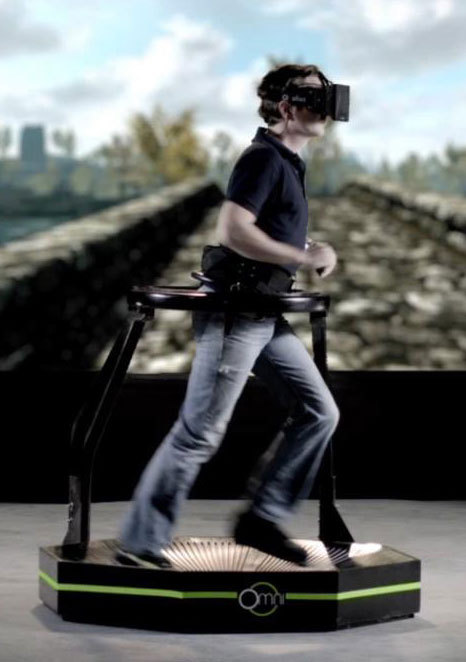Virtual Reality and Symbiosis

Back in the mid 1990’s at the Argonne National Lab, I was invited to see the CAVE (Cave Automatic Virtual Environment), a room large enough for a single person, with semitransparent walls, floor and ceiling that had stereo images projected onto them. Equipped with stereoscopic shutter glasses and a pressure-sensitive joystick, I had my first experience of virtual reality (VR), wrestling an enormous 3D molecule of some protein, mainly to stop it from going right through my body. My next contact with VR was at the headquarters of Silicon Graphics, in their Reality Center with a curved projection screen for what they called immersive visualization. And indeed, the out-of-body-experience in the cockpit of a fighter jet was immersive enough to give me motion sickness. And since then? Not much. For me and I guess for most people VR faded into the background towards the end of the nineties and was slapped with the labels of false promises and clunky and unaffordable technology.
But all that changed with the advent of the Oculus Rift, a set of two head-mounted displays, one for each eye, 3D audio and a motion sensor that keeps track of head movements. Though available only as development kit, it is inspiring a new generation of VR dreams. And with good reason: when it goes on sale sometime this year, for the price of a smart phone, it will launch VR in the consumer space. While the developers are contemplating killer apps for videos or gaming, more technology is on its way to make the experience even better: cameras like Nimble Sense to track hand and body movements, and the omnidirectional treadmill Virtuix Omni that allows the user to explore the virtual world on foot. With Oculus Rift at the centre, the VR industry is like a vortex sucking in more and more innovations, such as muscle sensing armbands or gloves for gesture control.

So far, on the way to full immersion of all our senses, we have only covered sight and hearing, so what’s with the other three? Our largest organ, the skin, is for haptic reception. While we would need a kind of suit to cover it all, haptic gloves are already being made. They provide the tactile feedback of holding a virtual object and let us feel its temperature and weight. The Aroma Shooter is the implementation of virtual smell, and the Digital Lollipop does the same for taste—small but important steps in the right direction.
But we don’t just sense the world—we interact with it, and this may be the biggest stumbling block on the way to perfect VR. In our virtual world of the future, can we ever hope to touch a person, sit on a chair, ride a horse, climb a rockface or handle tools or weapons? Perhaps if there was a material that can shapeshift on the spur of the moment and produce an object that we can lift up or that will support our weight, and that, if we walk it, flows the other way to keep us in place. A number of approaches, all in their infancy, exist with names like programmable matter, nanorobotics or utility fog. Even so, scientists at Carnegie Mellon University and Intel Research Labs Pittsburgh plan to have the first shape shifting objects brought forth by tiny micro robots in 2020.

As the virtual experience gets perfected, having to rely on physical items during longer sessions will become more and more of an irritation, and possibly the chief one of those will be food. An elegant solution would be to have it made on demand, in a way that preserves the richness of the eating experience we currently enjoy; and what better method is there than 3D printing? The company Natural Machines makes a device called foodini that does exactly that. While its repertoire is still limited to pizza, pasta and chocolate, it will go on sale in a few months time for the projected price of $1,300.
Let’s step back for a moment and pretend we have a crystal ball so we can look further into the future. Every successful step in improving the VR experience will increase the momentum, push VR in the gaming and movie industries and make it more attractive for other areas like retail or the workplace. This in turn will create economies of scale, accelerating progress even further until the last problem zones are ironed out.
When, at some point in the not too distant future, the experiences of VR and physical reality are on a similar level, it is not farfetched to think that living in VR for longer periods of time or even permanently will become a viable option. But as with all game-changing innovations there is a barrier to its adoption to be overcome. While technologies like telephone or e-mail can be taken on board by adding new practices to the daily routine, living in VR requires the replacement of old practices by new ones, which may make the adoption process harder than ever before. This could potentially mean a watershed moment in the development of humankind: while for many the lure of VR will be irresistible, others will vow to stay outside forever, and consequently, in a worst case scenario, society will split in two.
And this, finally, brings us to the world of “Symbiosis”, where two kinds of people are leading separate lives and yet depend on each other, where each part of humanity, liberated from the conflicting ideas of the other, is set free to shape their own destiny.
The novel “Symbiosis” is completed and is awaiting publication.

